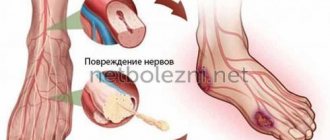What is this
Alcoholic polyneuropathy is a neurological disease caused by alcohol damage to nerve fibers and manifested by impaired sensitivity, movement and pain in the extremities (arms and legs). If left untreated, it leads to irreversible changes in the limbs and disability.
Seen by EVERYONE! alcohol abusers. But only no more than 30% of all sick patients turn to doctors with complaints of impaired sensitivity and gait.
Clinical picture
The clinical course of alcoholic polyneuropathy occurring without thiamine deficiency differs from the manifestations of the disease with severe vitamin B1 deficiency. Alcoholic polyneuropathy without thiamine deficiency progresses slowly. It manifests itself as increasing disorders of the sensory or motor function of the lower extremities. Due to damage to thin nerve fibers of the polyneurotic type, pain and temperature sensitivity is impaired, and vegetative-trophic disorders develop. 25–45% of patients complain of burning, aching or shooting pain. Movement disorders occur in the later stages of the disease. Added to the existing symptoms is weakness of the extensor muscles in areas of the legs located away from the body. In some patients, the movement disorder extends to the upper and lower extremities. It becomes difficult for them to climb stairs or get up from a sitting position. In this form of alcoholic polyneuropathy, the motor defect is moderately expressed. Neurologists determine it when performing functional loads. In severe cases of the disease, the upper limbs may also be involved in the pathological process.
Despite the predominantly slow progression of the disease, in some cases, symptoms of alcoholic polyneuropathy may appear suddenly, within a few days. Sensory disturbances that predominate in patients suffering from alcoholic polyneuropathy without vitamin B1 deficiency determine their severity of the condition. Even with a long-term course of the disease, the prognosis is relatively favorable. Motor functions remain intact in half of the patients.
Alcoholic polyneuropathy occurring without vitamin B1 deficiency is characterized by the following moderately pronounced autonomic disorders:
- difficulty urinating;
- constipation;
- orthostatic hypotension is a sharp decrease in blood pressure when getting out of bed.
In most patients, sweating is impaired, the pulse increases at rest, swelling and excessive pigmentation of the skin occurs.
There are dystrophic changes in the nails and changes in the color of the skin. Alcoholic polyneuropathy with thiamine deficiency is a distal symmetrical sensory-motor or motor-sensory form of the disease, in which the pathological process affects the upper and lower extremities. It develops in people who drink alcohol for a long time against the background of nutritional deficiency and insufficient intake of vitamin B1. Over the course of several months, patients experience weight loss. As the first manifestations of peripheral nerve damage, doctors consider paresthesia (a crawling sensation) and muscle weakness in the distal parts of the lower extremities, which spread in an ascending direction. Long-term and sensitive disorders can progress acutely (within one month) or chronically (more than one year). When examining patients, neurologists identify the predominance of sensory or motor disorders.
In 100% of patients suffering from this form of alcoholic polyneuropathy, neurological disorders develop in the upper extremities, and in more than half - in the lower extremities. During the examination, neurologists identify a pronounced decrease in the following types of sensitivity: temperature, pain, muscle-articular and vibration. This indicates that thick, well-myelinated, fast-conducting fibers of the peripheral nerves are affected.
Pain syndrome in patients suffering from alcoholic polyneuropathy with thiamine deficiency is less common than in the disease without vitamin B1 deficiency. In patients, tendon reflexes decrease or disappear early. Initially, weakness of the foot extensor muscles develops. As the disease progresses, it spreads towards the body, causing the patient to become completely immobile. Muscle wasting of the upper and lower extremities, sometimes atrophy due to contracture (immobility of joints), is determined. In half of the patients, a blood test reveals megaloblastic anemia (anemia). The concentration of B vitamins in the blood serum decreases.
Make an appointment
Symptoms
The very first signs of this disease are decreased sensitivity in the feet and legs. But patients usually do not pay attention to this. Later, the first unpleasant sensations appear - paresthesia in the legs or arms. In some cases, pain occurs in the legs, which intensifies with pressure on the muscles. When gross and irreversible destructive processes already occur in the nerve fibers, weakness in the legs, gait disturbances, and paralysis of the lower and upper extremities appear. The muscles begin to atrophy (decrease in size). In addition, changes in the skin are added: increased sweating, swelling, changes in color and skin turgor. In severe and long-term cases, decreased and loss of vision, cardiovascular, respiratory and gastrointestinal disorders are observed.
Kinds
Neurologists distinguish the following types of alcoholic polyneuropathy:
- sensory;
- motor;
- mixed;
- atactic;
- subclinical;
- vegetative.
With the sensory form of alcoholic polyneuropathy, patients experience pain in the distal parts of the extremities, a feeling of numbness, chilliness, and burning appears.
Sometimes cramps of the calf muscles appear. Pain and temperature sensitivity on the feet and palms increases or decreases. Sensory disturbances are accompanied by vegetative-vascular disorders: pale skin, increased sweating. Reflexes may decrease. In the motor form of alcoholic polyneuropathy, the pathological process often affects the lower extremities. Patients experience peripheral paresis and mild sensory disturbances. The mixed form of the disease is characterized by motor and sensory disturbances. Neurologists identify the following symptoms in patients:
- complete paralysis of the hands or feet;
- flaccid paresis;
- increased or decreased sensitivity in the affected areas.
In the atactic form of alcoholic polyneuropathy, coordination of movements and gait are impaired, a feeling of numbness appears in the legs, and increased sensitivity of the distal (lower) limbs develops. Doctors distinguish between chronic, acute and subacute, asymptomatic types of alcoholic polyneuropathy. In the chronic course of the disease, the clinical picture develops slowly over many years. The acute and subacute type of the disease is characterized by the rapid development of symptoms of the disease within a month. In patients suffering from chronic alcohol disease, polyneuropathy may be asymptomatic.
Treatment
A prerequisite for treatment is to stop drinking alcohol. As a rule, this becomes possible only when the patient begins treatment for alcohol dependence. In most cases, such treatment begins in a specialized 24-hour hospital.
Treatment methods for alcoholic polyneuropathy:
- Treatment of alcohol addiction.
- Vitamin therapy. B vitamins, ascorbic and nicotinic acid allow you to restore nerve cells and nerve fibers that have not yet died.
- Metabolic, neurometabolic therapy restores metabolism inside cells, improves the absorption of glucose and oxygen.
- Vascular therapy helps improve blood supply to all tissues of the body.
- Physiotherapy.
- Biofeedback therapy.
- Diet therapy.
- Exercise therapy, massage, occupational therapy.
Treatment of alcoholic neuropathy consists of two stages: active therapy in a hospital, lasting from 10 to 45 days; and rehabilitation (at home or in a specialized rehabilitation center) lasts from 1 to 12 months.
Diagnostics
During a neurological examination of patients suffering from alcoholic encephalopathy, neurologists determine an increase in tendon reflexes in the early stages of the disease, and a decrease in them in later stages. Muscle tone, as well as skin sensitivity, is reduced. With the development of muscle disorders, atrophy of the muscles of the limbs occurs in the shortest possible time. Damage to the calf muscles is accompanied by increased pain when palpating them and pressure on the area where the peripheral nerves pass. To confirm the diagnosis, doctors from the neurology department conduct a comprehensive examination of patients using the latest equipment from the world's leading manufacturers. It includes the following studies:
- sensory testing;
- electromyography;
- quantitative study of autonomic symptoms.
In order to establish a final diagnosis, a neurologist may prescribe the following studies:
- radiography;
- ultrasound screening of internal organs;
- spinal tap;
- general clinical analysis and biochemical blood test.
If there are indications, patients are consulted by related specialists: therapist, endocrinologist, ophthalmologist. Severe cases of alcoholic polyneuropathy are discussed at a meeting of an expert commission with the participation of doctors of the highest qualification category, doctors and candidates of medical sciences, who are experts in the field of complications of alcoholic illness.
Expert opinion
Author: Andrey Igorevich Volkov
Neurologist, Candidate of Medical Sciences
People who abuse alcohol are familiar with the feeling when their feet suddenly begin to get cold, and their skin tingles as if with needles. Some do not pay attention to this manifestation, others are sure that it is due to incorrect body position. However, at the first appearance of such a symptom, you should consult a doctor, because the manifestation is the main sign of developing alcoholic polyneuropathy.
As a result of drinking alcoholic beverages, which regularly have a strong toxic effect on the body, and the subsequent disruption of metabolic processes, an irreversible transformation of nerve fibers occurs. In the absence of timely therapeutic measures, a person faces disability.
First of all, the patient will be helped to get rid of alcohol addiction; without this condition, any treatment will be ineffective. The subsequent treatment strategy is aimed at regenerating the immune system, gastrointestinal tract organs, restoring the functionality of the nervous system, and eliminating painful manifestations.
According to statistics, women suffer from alcoholic polyneuropathy much more often than men. The risk of disease increases even if you drink 100 ml of ethyl alcohol per day. Doctors at the Yusupov Hospital will conduct a complete diagnosis of the patient, identify an accurate diagnosis, and, in accordance with the accompanying symptoms, prescribe comprehensive treatment.
Alcoholic polyneuropathy: clinical and pathogenetic variants, principles of diagnosis and treatment
Epidemiology
Alcoholism is a common and socially significant phenomenon. About 2 billion people around the world drink alcohol, and more than 76 million suffer from alcohol dependence. Chronic alcoholism is a disease characterized by the syndrome of drug addiction to alcohol. The latter leads to the development of specific somatic, neuropsychic disorders, and the emergence of social conflicts [1].
Currently, alcoholism and diseases directly related to it rank third among the causes of death, second only to cardiovascular diseases and neoplasms. According to the World Health Organization, 3.3 million people die each year worldwide as a result of alcohol consumption, accounting for 5.9% of all deaths [2]. Alcohol consumption often leads to death and disability in people of working age. In the 20–39 age group, approximately 25% of all deaths are attributable to alcohol [2].
Over the past half century, the level of alcohol consumption in Russia has increased several times. According to 2010 data presented in the report of the World Health Organization, Russia ranks fourth in the world in terms of alcohol consumption (15.1 liters per year) per capita of people aged 15 years and older [2].
Clinical picture
According to modern concepts, alcohol disease is a disease in which long-term ethanol intoxication leads to the occurrence of characteristic structural changes in the organs and systems of the body, manifested by corresponding clinical symptoms (a complex of mental, neurological and somatic disorders) [3].
The most common complication of alcoholic disease is alcoholic polyneuropathy, which occurs more often than alcoholic myopathy (diagnosed in 30–60% of patients), liver cirrhosis (15–20%), gastrointestinal tract damage (30–50%), cardiomyopathy (15 –35%), encephalopathy (1%) [4, 5]. According to various authors, the frequency of clinical forms of alcoholic polyneuropathy is 9–30%, and subclinical forms – up to 67–70% [6].
Currently, there are two main forms of alcoholic polyneuropathy: acute/subacute and chronic, which have different clinical presentations and development mechanisms, but can be combined with each other [7, 8].
Chronic alcoholic polyneuropathy
The morphological basis of damage to peripheral nerves during chronic alcohol intoxication is axonal degeneration, which is accompanied by secondary myelinopathy in the form of segmental de- and remyelination.
Chronic toxic polyneuropathy develops more often, which is caused by the direct toxic effects of ethanol and its metabolites and is accompanied by predominant damage to thin myelinated and unmyelinated fibers. The latter provide pain and temperature sensitivity and provide vegetative-trophic functions.
Clinical studies have proven that alcohol has a direct dose-dependent toxic effect on autonomic and somatic nerve fibers. An average daily dose of alcohol over 100 g significantly increases the likelihood of developing polyneuropathy, and the severity of its clinical manifestations directly depends on the total dose of ethanol [7, 8]. The mechanisms of the toxic effect of ethanol on peripheral nerves are still not well understood.
It is assumed that the toxic effect of ethanol and its metabolites on neurons occurs through activation of glutamate receptors in the spinal cord and, consequently, induction of glutamate neurotoxicity, activation of free radical lipid peroxidation, and increased production of proinflammatory cytokines. In addition, ethanol leads to a decrease in the synthesis and disruption of the normal configuration (misfolding) of nerve fiber cytoskeletal proteins and a slowdown in axonal transport [7, 9, 10]. Many representatives of the Asian race have impaired normal metabolism of ethanol due to the presence of a mutation in the gene encoding the synthesis of the enzyme aldehyde dehydrogenase. As a result, the level of toxic acetaldehyde in the body can exceed the norm by more than 20 times.
Acetaldehyde is able to form complexes with normal proteins, converting them into cytotoxic proteins, which in turn affect neurons, myocytes, and hepatocytes, leading to the development of liver cirrhosis, which further aggravates the severity of toxic alcoholic polyneuropathy. Experimental studies have obtained data on the activation of spinal cord microglial cells by ethanol and an increase in the functional activity of the hypothalamic-pituitary-adrenal and sympathoadrenal systems [11]. These changes, together with alcohol-induced oxidative stress, play a significant role in the formation of central sensitization in the spinal cord and, consequently, in the development of neuropathic pain syndrome, the phenomena of hyperesthesia and allodynia in alcoholic polyneuropathy. In general, neurons of the peripheral nervous system are more vulnerable to the effects of toxic products of alcohol metabolism than neurons of the central nervous system, protected by the blood-brain barrier.
In toxic alcoholic polyneuropathy, predominantly weakly myelinated fibers are affected, so the clinical picture is dominated by sensory and autonomic disorders. In most patients, the earliest clinical symptoms are paresthesia (sensations of “tingling”, “crawling”), as well as numbness in the distal parts of the legs; cramps in the muscles of the legs and feet are often observed. At the same time or somewhat later, a “burning” feeling and neuropathic pain in the extremities may occur, having a painful “burning”, “shooting” character, intensifying at night. It is possible to develop restless legs syndrome, the clinical basis of which is an imperative desire to move the limbs due to unpleasant sensations in them, more pronounced at night.
Toxic alcoholic polyneuropathy progresses slowly over several months or years. Beginning with damage to the distal lower extremities, symptoms spread to the proximal legs, lower torso, and in more severe cases to the upper extremities. In this clinical form, the sensory defect predominates over the motor one, and in half of the patients, even with a long course of the disease, motor disorders do not occur. Meanwhile, in other patients, weakness occurs mainly in the extensors of the feet and fingers, muscle wasting in the distal parts of the legs develops, and with a long course of the disease, weakness in the proximal parts of the legs and hands develops, and difficulty walking occurs.
A significant proportion of patients experience autonomic dysfunction, manifested by hyperhidrosis of the palms and feet, trophic disorders, changes in skin coloration, edema, as well as orthostatic hypotension, resting tachycardia, constipation, and gastroparesis. Disruption of the autonomic innervation of internal organs further aggravates metabolic disorders caused by the toxic effects of ethanol and its metabolites. Peripheral autonomic failure increases the risk of sudden death due to silent forms of myocardial infarction.
An objective neurological examination in patients most often reveals disturbances in pain and temperature sensitivity of the polyneuropathic type in the form of hypoesthesia or hyperesthesia; in some cases, symptoms of allodynia may develop. As a rule, already in the early stages of the disease, fading or loss of Achilles reflexes is noted. With further progression of the pathological process, a decrease or loss of knee reflexes, tendon reflexes from the hands, and the addition of weakness and wasting of the muscles of the extremities are revealed.
Acute and subacute alcoholic polyneuropathy
Along with chronic alcoholic polyneuropathy, characterized by slowly progressive damage to sensory, motor and autonomic fibers of peripheral nerves, there are also cases of alcoholic polyneuropathy with acute or subacute development of symptoms [6, 7, 12, 13]. In the pathogenesis of this form of alcoholic polyneuropathy, the leading role is played by deficiency of vitamin B1 (thiamine) and, possibly, other B vitamins. Alcohol consumption leads to thiamine deficiency in the body in several ways. Ethanol reduces the absorption of thiamine in the small intestine, reduces the supply of thiamine in the liver, reduces its intracellular phosphorylation, which leads to a decrease in the formation of the active form of this vitamin - thiamine diphosphate [7, 14–16]. In addition, patients suffering from chronic alcoholism, as a rule, have an inadequate, unbalanced diet, many of them develop diseases of the gastrointestinal tract (gastroduodenitis, peptic ulcer, pancreatitis), leading to malabsorption.
A decrease in the content of thiamine in the body leads to a reduction in the concentration of its active form - thiamine diphosphate, which serves as a cofactor for several enzymes involved mainly in the catabolism of carbohydrates, the biosynthesis of a number of cell constituents, components of the endogenous antioxidant system, and the synthesis of pentoses - nucleic acid precursors. As a result of vitamin B1 deficiency, the incorporation of lipids into myelin is reduced, the biosynthesis and metabolism of neurotransmitters is disrupted, and zones with lactic acidosis and intracellular calcium accumulation are formed in neurons, which potentiate the neurotoxic effect of alcohol. These data support the view that neuropathy in chronic alcohol intoxication is caused by vitamin B1 deficiency [7, 11, 16].
As a rule, the development of acute or subacute alcoholic polyneuropathy is preceded by a period of varying lengths of binge drinking, poor nutrition, and weight loss. Many patients have other manifestations of thiamine deficiency - Wernicke-Korsakoff encephalopathy, dilated cardiomyopathy. With chronic alcohol intoxication, there may be a deficiency of other B vitamins (B12, B6, B2), nicotinic and folic acids, and vitamin E. A polydeficiency state may be due to the characteristics of the clinical symptoms of polyneuropathy in each specific case, but a decrease in the content of these substances is not decisive in the development of peripheral nerve damage.
Unlike toxic polyneuropathy, thiamine-deficiency polyneuropathy usually has acute or subacute development of symptoms, although cases of slow progression are also possible. The initial symptom, as in the chronic form of alcoholic polyneuropathy, may be numbness in the distal parts of the legs, however, in most patients, due to damage to thick myelinated fibers, serious disorders of deep sensitivity develop, manifested by the syndrome of sensitive ataxia (a feeling of a “cushion” under the feet, instability and staggering when walking). walking, worse when closing eyes). Sensory disturbances are also observed in the distal parts of the arms.
Another feature of thiamine deficiency polyneuropathy is the early development and dominance of motor disorders in the clinical picture. A few days or weeks after the first symptoms of the disease, lower flaccid paraparesis debuts and increases, and then tetraparesis. Weakness of the limb muscles and sensory ataxia can be significant, limiting the ability of patients to move independently. Pain syndrome and autonomic dysfunction in this form of polyneuropathy are less common and manifest much less than in chronic toxic alcoholic polyneuropathy.
A neurological examination reveals lower paraparesis or tetraparesis with a predominance of motor disorders in the distal parts of the extremities, disorders of superficial and deep sensitivity of the polyneuropathic type, and sensitive ataxia. There is often a decrease or loss of tendon and periosteal reflexes from the lower and in some cases from the upper extremities. In some patients, cranial nerves may be involved in the pathological process, which is manifested by mild bulbar and oculomotor disorders.
Mixed form of alcoholic polyneuropathy
The most common is a mixed form of alcoholic polyneuropathy, in which the signs of toxic and thiamine-deficiency polyneuropathy are combined in various proportions and variations. Research results indicate that in the early stages of alcoholic polyneuropathy, due to the direct toxic effect of ethanol and its metabolites in the absence of nutritional deficiency and malabsorption in the intestine, the thin fibers of the leg nerves that conduct pain and temperature sensitivity suffer. With the progression of the disease and the addition of a deficiency of B vitamins, thick, well-myelinated proprioceptive and motor fibers of the peripheral nerves are involved in the pathological process [7, 8, 17].
Diagnostics
The clinical symptoms of alcoholic polyneuropathy are nonspecific, so when making a diagnosis it is important to assess the patient’s drug status and nutrition. Laboratory indicators, as a rule, reflect the degree of damage to liver tissue due to alcohol intoxication. An early sign of liver damage is considered to be elevated levels of liver transaminases (aspartate and alanine aminotransferase) or gamma-glutamyl transpeptidase. To clarify the presence of a deficiency of thiamine and other B vitamins, their concentration in the blood serum is examined. Thiamine deficiency is also confirmed by a decrease in transketolase activity of erythrocytes, which correlates with the level of thiamine in the blood. Examination of cerebrospinal fluid, as a rule, does not reveal changes [18]. Electroneuromyography is recognized as the main method for diagnosing alcoholic polyneuropathy, which makes it possible to objectify the level, nature and extent of damage to peripheral nerves. Alcoholic polyneuropathy is characterized by generalized symmetrical sensory-motor, predominantly distal axonopathy with signs of secondary myelinopathy.
When conducting stimulation electroneuromyography, a decrease in the amplitude of action potentials of sensory and motor nerves may be detected, which reflects damage to the axial cylinder of the nerve fiber - axonopathy. In addition, there is a decrease in the speed of propagation of excitation along the motor and sensory fibers of the nerves of the extremities in the distal and proximal sections, which is a sign of myelinopathy. These changes can be observed in patients who do not have clinical signs of alcoholic polyneuropathy, that is, at the subclinical stage of damage to the nerves of the extremities. As the disease progresses and neurological deficits in the sensory and motor spheres increase, the amplitudes of motor and sensory responses and the speed of propagation of excitation along the nerves decrease. In patients with acute and subacute forms of alcoholic polyneuropathy caused by thiamine deficiency, there is a more pronounced decrease in the amplitude of the motor response and the speed of excitation propagation along the motor fibers of the nerves of the limbs compared to similar indicators in toxic alcoholic polyneuropathy. These electroneuromyography results correlate with a more pronounced motor defect in patients with thiamine-deficiency polyneuropathy [7, 19–21].
In the diagnosis of various clinical forms of alcoholic polyneuropathy, needle electromyography is also used, which makes it possible to quantitatively assess the parameters of action potentials of motor units and identify signs of denervation in the muscle caused by axon damage - positive sharp waves, fibrillation potentials.
However, it should be taken into account that the absence of pathological changes according to electroneuromyography does not mean the absence of damage to peripheral nerves. The electroneuromyography method allows you to assess the condition of thick myelinated fibers of peripheral nerves. At the same time, in the chronic toxic form of alcoholic polyneuropathy, predominantly thin weakly myelinated or unmyelinated fibers are affected, so in these cases, electroneuromyography indicators remain within normal limits. To diagnose damage to thin fibers of peripheral nerves, the following techniques are used: quantitative sensory testing, laser evoked potentials, evoked potentials to thermal stimulation, and examination of intraepidermal nerve fibers.
Treatment
Considering the multifactorial mechanisms of the pathogenesis of alcoholic polyneuropathy, as well as combined damage to the liver and gastrointestinal tract, treatment in all cases requires an integrated approach under the supervision of doctors of various specialties: a neurologist, therapist, hepatologist, gastroenterologist. The prognosis for alcoholic polyneuropathy in most cases is favorable, neurological functions are restored, however, as a rule, a residual neurological defect remains. In addition, treatment requires a long period of time, since axonal regeneration and collateral sprouting are slow [7, 22].
A prerequisite for effective treatment of alcoholic polyneuropathy, as well as other manifestations of alcoholic illness, is a complete cessation of drinking alcoholic beverages, restoration of a well-balanced diet with sufficient amounts of vitamins and protein, as well as physical rehabilitation of the patient.
Many patients suffering from alcoholic polyneuropathy experience neuropathic pain syndrome. In the treatment of neuropathic pain, drugs from the group of antidepressants and anticonvulsants, as well as their combinations, are used. Among antidepressants, tricyclic antidepressants (amitriptyline), as well as serotonin and norepinephrine reuptake inhibitors (duloxetine and venlafaxine) have proven the most effective in the treatment of neuropathic pain (evidence level B). An alternative is therapy with anticonvulsants – pregabalin (evidence level A), gabapentin (evidence level B). Anticonvulsants from the valproic acid group and lamotrigine showed less effectiveness in clinical studies [7, 8, 11].
Antioxidants in the treatment of alcoholic polyneuropathy
Considering the proven role of oxidative stress in the pathogenesis of alcohol-induced peripheral nerve damage, it is reasonable to use drugs from the group of antioxidants. The most widely used in the treatment of polyneuropathy of alcoholic origin are preparations of alpha-lipoic (thioctic) acid, in particular Espa-Lipon.
Alpha lipoic acid was discovered by EE Snell et al. in 1937, who discovered that certain bacteria required potato extract to grow [23]. In 1951, LJ Reed et al. isolated the so-called potato growth factor (alpha-lipoic acid), and the participation of alpha-lipoic acid as a coenzyme in the Krebs cycle and in the elimination of free radicals was soon shown [24]. Alpha lipoic acid was originally known as an essential biochemical cofactor for mitochondrial enzymes. However, in the last decade it has been discovered that alpha lipoic acid and its metabolic intermediate dihydrolipoic acid are powerful antioxidants.
The uniqueness of alpha lipoic acid as an antioxidant lies in its ability to:
- directly eliminate free radicals;
- regenerate endogenous antioxidants such as glutathione, vitamins E and C;
- reduce the production of free radicals due to metal chelate activity.
Alpha-lipoic acid was first used for therapeutic purposes in 1966 by German clinicians for the treatment of diabetic polyneuropathy and liver cirrhosis, as data were obtained on low levels of alpha-lipoic acid in this category of patients [25]. Alpha-lipoic acid has been shown to improve endoneurial blood flow and nerve conduction in animal models of experimental diabetes [25]. Decades of clinical use of alpha-lipoic acid have accumulated extensive evidence of its effectiveness against the symptoms of diabetic polyneuropathy.
At the same time, studies on the effectiveness of alpha-lipoic acid in alcoholic polyneuropathy are still rare. Alpha lipoic acid has been shown to be effective in 70% of patients with alcoholic polyneuropathy. It affects multimodal sensory and motor symptoms caused by damage to various peripheral nerve fibers [25]. In addition, there is evidence of a direct effect of alpha-lipoic acid on ethanol-mediated neurotoxicity in vivo [25, 26].
Treatment usually begins with intravenous administration of alpha-lipoic acid at a daily dose of 600 mg for 14–15 days. In the future, they switch to tablet forms of drugs. Espa-Lipon is recommended to be taken at a dose of 600 mg per day in the morning on an empty stomach; the duration of administration is determined by the specific clinical situation and usually varies from two to six months. In most cases, the drug is well tolerated by patients and causes virtually no side effects.
The role of B vitamins in the treatment of patients with alcoholic polyneuropathy
B vitamins, primarily B1 (thiamine), B6 (pyridoxine), B12 (cyanocobalamin), are neurotropic and have been widely used for many years in the treatment of diseases of the central and peripheral nervous system. Considering that a decrease in the concentration of thiamine (and in some cases other B vitamins) in the blood is observed in 40–80% of people with chronic alcoholism [27], and in thiamine-deficient (acute and subacute) forms of alcoholic polyneuropathy, vitamin B1 deficiency is the leading pathogenetic factor its development, the use of B vitamins in the treatment of alcoholic polyneuropathy is pathogenetically justified. Before starting treatment, it is advisable to determine the concentration of thiamine in the blood or evaluate the activity of erythrocyte transketolase [7, 27]. B vitamins can be prescribed in the absence of their deficiency due to the active participation of this group of vitamins in biochemical processes that ensure the normal functioning of the structures of the nervous system [28].
In practice, in the treatment of alcoholic polyneuropathy, combination preparations of B vitamins are most often used. In addition to thiamine, they include pyridoxine (vitamin B6) and cyanocobalamin (vitamin B12). Experimental and clinical studies have shown that the components of combination preparations of B vitamins potentiate each other’s effects [27].
The active form of thiamine, thiamine diphosphate, is necessary for the oxidative decarboxylation of keto acids (pyruvic and lactic) and the synthesis of acetylcholine. Acetylcholine is involved in carbohydrate metabolism and ensuring axonal transport, which determines the regeneration of nervous tissue, and also has a regulatory effect on the trophism of the nervous system. Thiamine in alcoholic neuropathy, replenishing the resulting deficiency and restoring the activity of key enzymes, allows you to stop the progression of polyneuropathy and promotes a more complete and rapid recovery of the neurological deficit.
The phosphorylated form of pyridoxine serves as a cofactor for more than 100 enzymes and takes part in the synthesis of various mediators: catecholamines, histamine and gamma-aminobutyric acid. In its phosphorylated form, the drug ensures the processes of decarboxylation, transamination, deamination of amino acids, participates in the synthesis of protein, enzymes, hemoglobin, prostaglandins, improves the absorption of unsaturated fatty acids, reduces the level of cholesterol and lipids in the blood, improves myocardial contractility, promotes the conversion of folic acid into its active form . In addition, it increases intracellular reserves of magnesium, which plays an important role in metabolic, in particular energy, processes in the nervous system.
Vitamin B12 is involved in the construction of protein and fatty structures of the myelin sheath of nerve fibers; as part of coenzymes, it promotes cell replication and growth. Vitamin B12 and methionine (as well as vitamin C) play an important role in the functioning of the central and peripheral nervous system, participating in metabolism in the production of monoamines [27–29].
Controlled studies have proven the effectiveness of B complex vitamins in the treatment of positive and negative symptoms of alcoholic polyneuropathy [28]. It should be noted that the studies included patients who had a sensory form of polyneuropathy. It can be assumed that the main cause of peripheral nerve damage was the toxic effect of ethanol, and not thiamine deficiency. The obtained therapeutic effect confirms the advisability of prescribing B vitamins to patients with chronic alcohol intoxication in the presence of polyneuropathy, regardless of its pathogenetic mechanisms (toxic or thiamine deficiency). Considering that deficiency of B vitamins plays a leading role in the development of other clinical forms of damage to the nervous system in alcoholism (Haye-Wernicke-Korsakoff encephalopathy, alcoholic dementia), it is advisable to prescribe them in these cases as well.
The use of the water-soluble form of thiamine orally in therapeutic doses is limited by its relatively low bioavailability: water-soluble thiamine is poorly absorbed and is partially destroyed by intestinal thiaminase, in which it is mainly absorbed. When increasing the dose of water-soluble thiamine, a “saturation” effect occurs when, despite increasing the dose, its concentration in the blood does not increase significantly, which is explained by blocking its transfer from the intestine to the blood. After the concentration of thiamine in the blood increases to more than 2 µmol/l, active sodium-dependent transport is replaced by less effective passive diffusion. The maximum possible absorption from the gastrointestinal tract is 10%, and no more than 15 mg can be absorbed per day. At high concentrations in the blood, thiamine is actively excreted by the kidneys almost unchanged.
The solution to this problem was the creation of fat-soluble forms of thiamine that do not have the disadvantages inherent in the water-soluble oral form of vitamin B1. Such forms were synthesized in Japan in the 1950s. to prevent pandemic beriberi disease, and the entire group of fat-soluble thiamines was named allithiamins. Benfotiamine among all allithiamins has the greatest bioavailability and the least toxicity, penetrating into the body through the mechanism of passive dose-dependent diffusion, it has almost 100% bioavailability. In addition, benfotiamine is not destroyed by intestinal thiaminases, which makes it possible to achieve maximum effect when using it. It has been established that benfotiamine increases the activity of the transketolase enzyme [27, 28, 30, 31].
The controlled BAP 1 STUDY study demonstrated the effectiveness of benfotiamine against sensory and motor manifestations of alcoholic polyneuropathy [30, 31].
In addition, in the middle of the twentieth century. the analgesic effect of B vitamins has been established. It is believed that vitamin B12 has the most pronounced analgesic properties. According to the results of modern studies, benfotiamine also significantly reduces the intensity of pain in alcoholic polyneuropathy [32].
Experimental work has shown that under the influence of a combination of B vitamins, nociceptive responses caused by formaldehyde are inhibited, which is not observed after the administration of naloxone. It is believed that the antinociceptive effect of the combined vitamin complex may be due to inhibition of synthesis and/or blocking the action of inflammatory mediators.
It has been established that the B complex of vitamins enhances the effect of the main antinociceptive neurotransmitters - norepinephrine and serotonin. In addition, animal experiments revealed suppression of nociceptive responses not only in the dorsal horn of the spinal cord, but also in the thalamus optica.
Clinically and in experimental models, B vitamins have been shown to enhance the analgesic effect of nonsteroidal anti-inflammatory drugs, anticonvulsants, and antidepressants in neuropathic pain syndromes. Given the significant prevalence of neuropathic pain in patients with alcoholic polyneuropathy, the analgesic effect of vitamin B complex is of important therapeutic importance.
Dosage forms and routes of administration of B vitamins
Monotherapy with vitamins B1, B6 or B12 can be carried out. There are water-soluble forms for parenteral administration and for oral administration in the form of tablets or dragees. To quickly achieve high concentrations of vitamins in the blood and cytoplasm of cells, preference is given to parenteral administration of large doses of water-soluble forms of B vitamins.
However, in case of alcoholic polyneuropathy, it is advisable to use B vitamins not alone, but in combination. A widely known combination preparation of B vitamins is Milgamma (ampoules), which contains 100 mg of thiamine, 100 mg of pyridoxine and 1000 mcg of cyanocobalamin. Considering that thiamine deficiency in alcoholic polyneuropathy in many cases develops due to impaired absorption in the intestine, it is advisable to begin treatment of severe forms of alcoholic polyneuropathy with parenteral administration of the drug. This ensures a faster and more guaranteed onset of the therapeutic effect. Milgamma is usually prescribed intramuscularly in a dose of 2 ml (one ampoule) for ten days. Milgamma has a small ampoule volume (only 2 ml), and also contains the local anesthetic lidocaine (20 mg), which makes injections virtually painless and increases patient adherence to therapy [28].
After parenteral administration, it is necessary to consolidate the effect by oral administration of B vitamins, for which you can use the drug Milgamma compositum, containing 100 mg of lipophilic benfotiamine and 100 mg of pyridoxine. The standard treatment course involves taking three tablets per day for two to three months.
In all cases, patients with alcoholic polyneuropathy require continuous long-term administration of thiamine. When prescribing combination drugs, it should be taken into account that with long-term use of high doses of pyridoxine, there is a risk of developing toxic sensory polyneuropathy [27, 28]. For long-term maintenance therapy of alcoholic polyneuropathy, the drug Benfogamma is especially suitable, which contains 150 mg of benfotiamine and is taken one tablet per day for a long time.
Thus, the results of controlled clinical studies have proven the pathogenetic validity, effectiveness and safety of the use of combined preparations of B vitamins for alcoholic polyneuropathy.
Reasons for the formation of pathology
Obvious signs of the disease make themselves felt in cases of advanced alcoholism. They are detected in patients with stages II and III of chronic alcohol dependence.
Causal factors leading to alcoholic polyneuropathy:
- Toxic demyelination of neuronal axons.
- Avitaminosis.
- Accumulation of acetaldehydes in the blood.
Low-quality alcohol, denatured alcohols, and non-edible liquids containing ethanol have a particularly destructive effect. Sometimes one dose of a toxic substance is enough to form polyneuritis. Hereditary deficiency of enzymes that neutralize the products of ethanol catabolism in the liver is also important.
- The process gets worse:
- Thiamine (vitamin B1) deficiency.
- Poor nutrition, due to lack of appetite during binge drinking, financial difficulties of an alcoholic who prefers to buy alcohol rather than normal food.
- Violation of the detoxification function of the liver.
Characteristic
This disease occurs due to poisoning of the body. Intoxication with breakdown products of alcohols has another name - alcoholic polyneuropathy. This form of neuritis is a consequence of inflammation of many peripheral nerve endings and parts of the spinal cord. The disease occurs with damage to the nervous system. The rate of development of the disease is determined by hereditary factors, a metabolic feature in which the body produces acetaldehyde dehydrogenase and alcohol dehydrogenase.
Characteristic signs of alcoholic polyneuropathy are:
- loss of sensation in the limbs,
- increased fatigue,
- sleep disturbance,
- decreased sensitivity of the whole body.
Stages of polyneuropathy
- At stage zero, the disease itself is absent, there are no signs of pathology, even special studies cannot identify symptoms (sensory testing and other techniques are used).
- At the first stage, the disease is asymptomatic, no clinical signs are observed, but pathological changes in the body can be detected using special techniques.
- The second stage is the so-called significant polyneuropathy. Diagnosis of the disease is possible on the basis of certain symptoms, patient complaints, studies; no pronounced functional defect is observed.
- The third stage is a disease with pronounced symptoms and significant functional impairments. Symptoms are obvious, pronounced, low level of ability to work.
Content:
- Reasons for development
- Symptoms
- Treatment
Alcohol addiction often affects the nervous system. Alcoholic polyneuropathy is a disease in which a large number of peripheral nerves are simultaneously affected.
The clinically pronounced form, according to various sources, is diagnosed in 10–30% of people with chronic alcoholism. In special studies, signs of an asymptomatic course are found in the majority of alcoholics. Pathology is more often detected in males. Usually occurs chronically. The sudden appearance of symptoms is sometimes observed under the influence of provoking factors - hypothermia or prolonged heavy drinking. The rate of progression and severity of manifestations vary. In severe cases, disability cannot be ruled out.
Literature:
- Guide to neurology according to Adams and Victor: textbook. manual for the postgraduate system. prof. physician education / Maurice Victor, Allan H. Ropper; scientific ed. V. A. Parfenov; lane from English edited by N. N. Yakhno. — 7th ed. — Moscow: Med. information agency, 2006. - 677 p.
- Peripheral nervous system in normal and pathological conditions: [educational manual] / N. S. Subbotina; Federal Agency for Education, State. higher educational institution prof. Education Petrozavodsk State univ. - Petrozavodsk: PetrSU Publishing House, 2006. - 129 p.
- Classical neurology: a guide to the peripheral nervous system and chronic pain syndromes / Silantiev Konstantin. - Volgograd: Panorama, 2006 (Volzhsky: Alliance Yugpoligraphkombinat, Volzhsky polygraphkombinat). — 399 p.
The text was checked by expert doctors: Head of the socio-psychological service of the Alkoklinik MC, psychologist Yu.P. Baranova, L.A. Serova, a psychiatrist-narcologist.
CAN'T FIND THE ANSWER?
Consult a specialist
Or call: +7 (495) 798-30-80
Call! We work around the clock!











